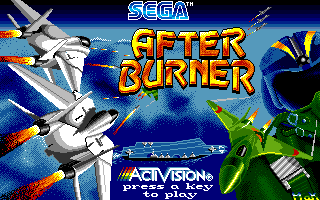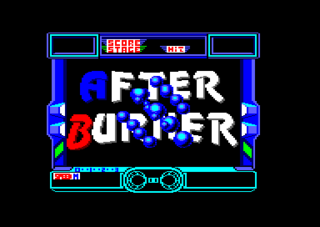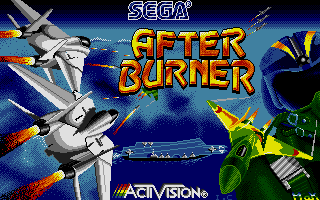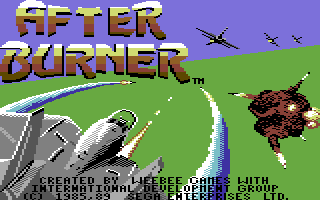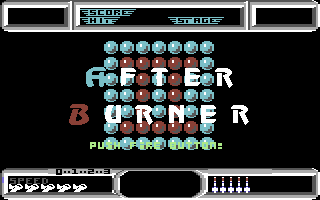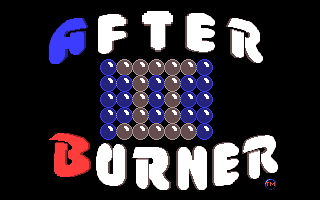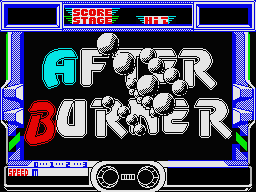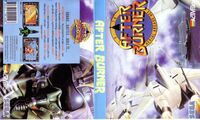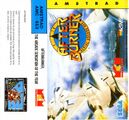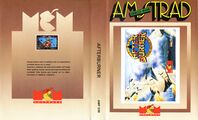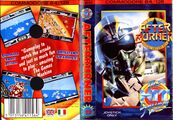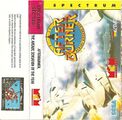After Burner (home computers)
From Sega Retro
- For other versions of the game see After Burner and After Burner II.
| After Burner | ||||||||||||||||||||||||||||||||||||||||||||||||||||||||||||||||||||||||||||||||||||||||||||||||||||
|---|---|---|---|---|---|---|---|---|---|---|---|---|---|---|---|---|---|---|---|---|---|---|---|---|---|---|---|---|---|---|---|---|---|---|---|---|---|---|---|---|---|---|---|---|---|---|---|---|---|---|---|---|---|---|---|---|---|---|---|---|---|---|---|---|---|---|---|---|---|---|---|---|---|---|---|---|---|---|---|---|---|---|---|---|---|---|---|---|---|---|---|---|---|---|---|---|---|---|---|---|
| System(s): Amiga, Amstrad CPC, Atari ST, Commodore 64, IBM PC, MSX, ZX Spectrum | ||||||||||||||||||||||||||||||||||||||||||||||||||||||||||||||||||||||||||||||||||||||||||||||||||||
| Publisher: Sega of America (US) Activision (UK) MCM Software (ES) | ||||||||||||||||||||||||||||||||||||||||||||||||||||||||||||||||||||||||||||||||||||||||||||||||||||
| Developer: Weebee Games (US) Argonaut Software (EU) International Development Group (US) Focus (EU) Unlimited Software | ||||||||||||||||||||||||||||||||||||||||||||||||||||||||||||||||||||||||||||||||||||||||||||||||||||
| Genre: Shoot-'em-Up | ||||||||||||||||||||||||||||||||||||||||||||||||||||||||||||||||||||||||||||||||||||||||||||||||||||
|
The Western home computer versions of After Burner are shoot-'em-up games released between 1988 and 1991. Despite their names, all are actually conversions of After Burner II, and most refer to themselves as such in-game.
Two versions for both the Amiga and Commodore 64 were released; a set for North American audiences (1988) and another for the European market (1989).
Contents
Versions
In the arcades, After Burner (II) relies on real-time hardware sprite scaling which was not supported on any of these formats. As such, just like the home ports of Space Harrier and OutRun, the effect is simulated by switching between different-sized sprites during gameplay, giving a choppier and more simplified look. A benefit of After Burner is that the player's F-14 Tomcat travels much faster than the player does in the aforementioned games, so the choppiness is less obvious.
After Burner does, however, simulate the ground using this method. Due to graphical limitations, the simpler home computers opted to use a solid colour as the ground, which means transitions between levels are more abrupt (although the multi-load nature of the 8-bit versions means a pause is often necessary anyway).
These home computer versions have the plane automatically fire its machineguns at all times, likely as standard computer joysticks of the era only had one button (which in After Burner's case is used for missiles). The space bar is used to either increase or decrease the speed depending on the situation.
The Amstrad CPC version does not include any in-game music. The ZX Spectrum 128K and MSX versions are identical (48K Spectrum owners can also play the game, albeit with no music), though the MSX port runs slower due to a lack of optimisation for the system. Neither version offers the bonus rounds.
Two versions exist for the Commodore 64, built by entirely different teams for different markets. The earlier North American version is played in full screen and is arguably the more accurate of the two, but runs slower, has a very limited HUD and has no in-game music. The European version, by contrast, is faster and has music, but plays in a window. There are also colour clashing issues when enemy planes are drawn above the ground, and the level order is different.
The IBM PC version supports VGA, EGA and CGA graphics (though very little separates the VGA and EGA modes, as the former still restricts itself to 16 colours), but only the PC Speaker as a form of sound (which it also uses for music, to varying degrees of success). Missiles are generally harder to avoid in the IBM version, and the HUD is mostly text-based rather than using the icons seen in the arcade version.
The 16-bit Atari ST version is predictably more accurate than its 8-bit counterparts, and features higher frame rates and sampled speech (which causes minor slowdown when playing). The game cannot handle both music and sound effects concurrently so the user has to choose between the two. Similar to Space Harrier, it can also be played with a mouse.
Again, two different versions for the Amiga were produced, one for North American markets and another for Europe, the latter being an ST port, with better music. The North American version uses a full-screen display but runs slower.
History
Release
Retailers expected the Activision versions of After Burner to be collectively the best selling game in the United Kingdom of Christmas 1988[11]. In the end, they were fifth, ranked behind Ocean Software's home conversions of Operation Wolf and RoboCop, the budget release of Ghostbusters by Mastertronic and Double Dragon by Melbourne House[12].
Production credits
Amiga version (US)
- Programmed by: Jeff Spangenberg
- Graphics by: Matthew Stubbington
- Level Desgin and additonal graphics by: Darrin Stubbington
- Music and sound effects by: Jason Brooke
Amiga version (EU)
- Programmed By Argonaut Software Ltd.
- Code C 1985 1988 Argonaut Software Ltd
- Music and Sound Effects By Uncle Art
- Artwork By Focus C.E. Ltd.
- A Software Studios Production
Commodore 64 version (EU)
- This game has been produced under license from Sega Enterprises Ltd Japan and used by Activision UK Ltd
- Coding by: Dalali Software Ltd
- Graphics by: Focus CE Ltd
- Music by: Adam Gilmore
- A Software Studios Production
- Copyright Sega 1988
Commodore 64 version (US)
- Music: Jeroen Tel
IBM PC version
- Programmer: Jack Rebbetoy
- Graphic Artsits: Gerard DeSouza, Faye Hoffman
- Unlimited Software Inc.
Magazine articles
- Main article: After Burner (home computers)/Magazine articles.
Promotional material
also published in:
- Soft Today (DK) #2: "Februar 1989" (1989-01-xx)[18]
Physical scans
Amiga version
| Sega Retro Average | |||||||||||||||||||||||||||||
|---|---|---|---|---|---|---|---|---|---|---|---|---|---|---|---|---|---|---|---|---|---|---|---|---|---|---|---|---|---|
|
| 49 | |
|---|---|
| Based on 5 reviews | |
| Amiga, UK |
|---|
|
| Amiga, UK (The Hit Squad) |
|---|
|
Amstrad CPC version
| Sega Retro Average | ||||||||||||||||||||||||
|---|---|---|---|---|---|---|---|---|---|---|---|---|---|---|---|---|---|---|---|---|---|---|---|---|
|
| 67 | |
|---|---|
| Based on 4 reviews | |
| Amstrad CPC, UK (cassette) |
|---|
|
| Amstrad CPC, UK (disk) |
|---|
|
Atari ST version
| Sega Retro Average | |||||||||||||||||||||||||||||
|---|---|---|---|---|---|---|---|---|---|---|---|---|---|---|---|---|---|---|---|---|---|---|---|---|---|---|---|---|---|
|
| 43 | |
|---|---|
| Based on 5 reviews | |
| Atari ST, UK (The Hit Squad) |
|---|
Commodore 64 version
| Sega Retro Average | ||||||||||||||||||||||||||||||||||||||||||||||||||||||
|---|---|---|---|---|---|---|---|---|---|---|---|---|---|---|---|---|---|---|---|---|---|---|---|---|---|---|---|---|---|---|---|---|---|---|---|---|---|---|---|---|---|---|---|---|---|---|---|---|---|---|---|---|---|---|
|
| 43 | |
|---|---|
| Based on 10 reviews | |
| Commodore 64, UK (cassette) |
|---|
|
| Commodore 64, UK (The Hit Squad) |
|---|
IBM PC version
| Sega Retro Average | ||||||||||||||
|---|---|---|---|---|---|---|---|---|---|---|---|---|---|---|
|
| 54 | |
|---|---|
| Based on 2 reviews | |
MSX version
ZX Spectrum version
| Sega Retro Average | ||||||||||||||||||||||||||||||||||
|---|---|---|---|---|---|---|---|---|---|---|---|---|---|---|---|---|---|---|---|---|---|---|---|---|---|---|---|---|---|---|---|---|---|---|
|
| 71 | |
|---|---|
| Based on 6 reviews | |
| ZX Spectrum, UK (cassette) |
|---|
|
| ZX Spectrum, UK (The Hit Squad) |
|---|
References
- ↑ 1.0 1.1 1.2 VideoGames & Computer Entertainment, "September 1990" (US; 1990-0x-xx), page 150
- ↑ 2.0 2.1 2.2 2.3 2.4 2.5 2.6 The Games Machine, "December 1988" (UK; 1988-11-17), page 17
- ↑ 3.0 3.1 ACE, "June 1989" (UK; 1989-05-04), page 77
- ↑ 4.0 4.1 4.2 4.3 Computer & Video Games, "December 1988" (UK; 1988-11-xx), page 16
- ↑ Raze, "March 1991" (UK; 1991-01-31), page 93
- ↑ 6.0 6.1 6.2 6.3 Computer & Video Games, "December 1988" (UK; 1988-11-xx), page 17
- ↑ 7.0 7.1 Commodore Format, "April 1991" (UK; 1991-03-21), page 43
- ↑ 8.0 8.1 8.2 The Games Machine, "April 1989" (UK; 1989-03-23), page 31
- ↑ File:CGW US 065.pdf, page 92
- ↑ 10.0 10.1 Computer & Video Games, "April 1991" (UK; 1991-03-16), page 72
- ↑ File:TGM UK 13.pdf, page 10
- ↑ The Games Machine, "March 1989" (UK; 1989-02-16), page 92
- ↑ ACE, "November 1988" (UK; 1988-xx-xx), page 36
- ↑ ACE, "December 1988" (UK; 1988-xx-xx), page 54
- ↑ Computer & Video Games, "January 1989" (UK; 1988-12-16), page 90
- ↑ ACE, "January 1989" (UK; 1989-xx-xx), page 100
- ↑ ACE, "February 1989" (UK; 1989-xx-xx), page 62
- ↑ Soft Today, "Februar 1989" (DK; 1989-01-xx), page 32
- ↑ Commodore User, "May 1989" (UK; 1989-04-26), page 69
- ↑ The Games Machine, "May 1989" (UK; 1989-04-20), page 39
- ↑ Score, "Březen 1995" (CZ; 1995-03-01), page 1
- ↑ 22.0 22.1 Zzap!64, "January 1991" (UK; 199x-xx-xx), page 60
- ↑ ACE, "April 1989" (UK; 1989-03-02), page 84
- ↑ Amstrad Action, "February 1989" (UK; 1989-01-12), page 40
- ↑ 25.0 25.1 25.2 Tilt, "Mars 1989" (FR; 1989-0x-xx), page 66
- ↑ 26.0 26.1 26.2 ACE, "January 1989" (UK; 1989-xx-xx), page 54
- ↑ 27.0 27.1 27.2 The Games Machine, "February 1989" (UK; 1989-01-19), page 59
- ↑ New Computer Express, "November 26, 1988" (UK; 1988-11-24), page 31
- ↑ The One, "January 1989" (UK; 1988-12-xx), page 32
- ↑ Commodore Format, "July 1992" (UK; 1992-06-18), page 47
- ↑ Commodore User, "December 1988" (UK; 1988-11-26), page 16
- ↑ Zzap!64, "March 1989" (UK; 1989-02-16), page 78
- ↑ Zzap!, "Gennaio 1989" (IT; 198x-xx-xx), page 12
- ↑ Zzap!, "Giugno 1989" (IT; 1989-xx-xx), page 40
- ↑ Aktueller Software Markt, "März 1990" (DE; 1990-0x-xx), page 60
- ↑ Joystick, "Mars 1990" (FR; 1990-02-20), page 145
- ↑ Computer & Video Games, "December 1988" (UK; 1988-11-xx), page 52
- ↑ New Computer Express, "November 19, 1988" (UK; 1988-11-17), page 28
- ↑ Your Sinclair, "May 1991" (UK; 1991-04-xx), page 69
| After Burner (home computers) | |
|---|---|
|
Main page | Comparisons | Hidden content | Magazine articles | Reception | |
- No players field
- US Amiga games
- All US games
- UK Amiga games
- All UK games
- Amiga games
- All shoot-'em-up games
- 1988 Amiga games
- All 1988 games
- UK Atari ST games
- Atari ST games
- 1988 Atari ST games
- ES Amstrad CPC games
- All ES games
- UK Amstrad CPC games
- Amstrad CPC games
- 1988 Amstrad CPC games
- US Commodore 64 games
- UK Commodore 64 games
- Commodore 64 games
- 1988 Commodore 64 games
- ES ZX Spectrum games
- UK ZX Spectrum games
- ZX Spectrum games
- 1988 ZX Spectrum games
- US IBM PC games
- IBM PC games
- 1988 IBM PC games
- UK MSX games
- MSX games
- 1988 MSX games
- All games
- Credits without source
- Credits without reference
- After Burner (home computers)
- After Burner (franchise)
